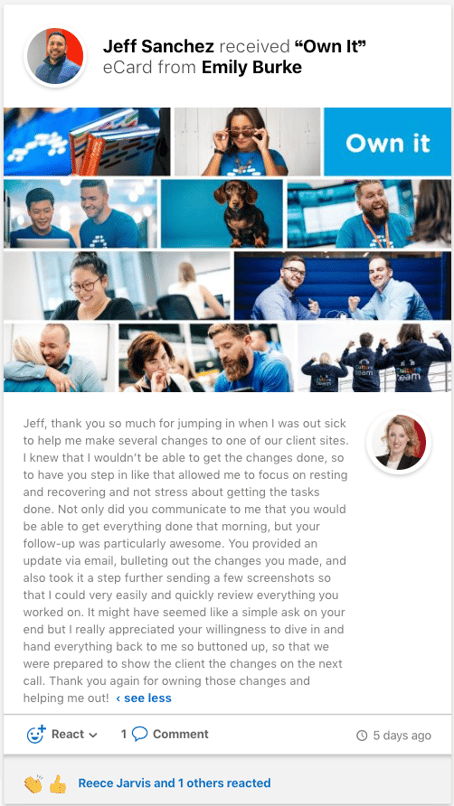4 min read
Recognising people for the work they do is part of building a strong, healthy workplace. And employee recognition is powerful. It has the potential to inspire people to adopt new ways of doing things, it helps foster a culture of appreciation and gratitude and it can also help your organisation reach its desired goals and objectives.
Let's take this a step further. Strategic recognition is when you show appreciation for a success that helped improve the employee or customer experience and that can be tied to your company’s values, purpose or objectives.
Just because we’re being strategic doesn’t mean we have to be boring.
Rather, think about how adding a little bit more beyond the “thank you” can turn a nice message into one that has a meaningful impact on your team and your company as a whole.
Don’t worry… writing the perfect strategic recognition message is easy! It only involves three steps. And once you get into the habit of doing it, you won’t think twice the next time you go to acknowledge someone for doing a good job.

Step 1: Tell the action
It sounds simple because it is. What specific actions did the person do? Tell the story in a couple of sentences. It doesn’t need to be a novel, just enough information so people who may not work with that individual every day know what happened. Telling the action ensures that others on your team will be more informed of great work and the types of actions they can do to deliver on your company’s mission, purpose and values.
Helpful tip: Think about telling the story in a way that a new employee can clearly understand what they would do in a similar situation.
Being specific also makes sure that the recognition is genuine, focussed on merit and doesn’t feel like favouritism.
Step 2: Connect to an area of focus or company value
Employee recognition is a great opportunity to tie employee actions to your company’s values, goals, mission or purpose. This helps people on your team make the connection between what they do every day with the big picture of your organisation's priorities and objectives.
It’s key to “walk the talk,” especially as a leader. Connecting the recognition message to the values, purpose, etc., demonstrates that those important pieces of your business are top of mind for you too! As you lead by example, people on your team will adopt the practice and soon enough, that link between the values and day-to-day actions will become easier to see.
Step 3: Explain the impact
This step is about the result of the action. Why was it important and how did it affect your team, your customers or the company as a whole? Again, get specific – if you only report on what happened, you miss out on the appreciation piece that influences engagement and creates an inspiring moment.
While the benefit of the action may seem obvious to you, it may not be to others, especially if they are not on the same team or in the same department.
Helpful tip: You may even want to consider what would have been the impact if the person did not do what they did.
In a webinar poll I recently conducted, over half of the participants said that sharing the impact is the step most likely to be overlooked. My advice? Don’t skip it. Sharing the impact shows the individual you respect the work they do, even if it just means doing their job consistently well. And sharing the impact further highlights the relevance and purpose of an individual’s role on tangible business results.
Before we wrap up, here’s an example from one of our team members demonstrating the RG value of Own It:

As you can see, Emily shares what Jeff did, how it supports our values and the impact it had on the team, and ultimately, the client.
| To recap, here are the three steps to make employee recognition more strategic: |
| Step one: Tell the action |
| Step two: Connect to an area of focus or company value |
| Step Three: Explain the impact |
I hope this got you excited to incorporate strategic recognition into your workplace, but let’s not forget that many different types of recognition are important. Being strategic doesn’t mean we stop saying a quick thank you or giving a high-five for someone coming to work on time every day for a month. These types of recognition also contribute to the overall engagement of the people you work with.
So consider: How can you incorporate strategic recognition to boost and round out your company’s employee engagement efforts?

%20(1).jpeg) Alexandra Powell
Alexandra Powell

